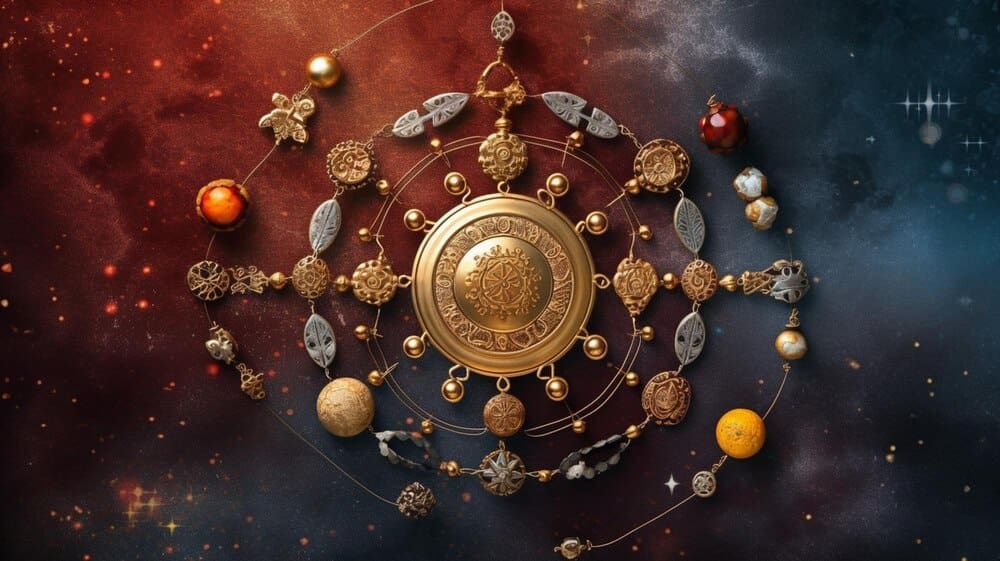Shatabhisha Nakshatra, the 24th lunar mansion in Vedic astrology, represents a profound and often misunderstood cosmic energy, governing individuals born when the Moon transits between 6°40′ and 20°00′ of the zodiac sign Aquarius. Known as the “Star of Veiling” or “The Hundred Healers,” this asterism embodies the dual principles of secrecy and revelation, concealment and profound healing. Ruled by the shadowy planet Rahu and presided over by the cosmic deity Varuna, Shatabhisha natives are tasked with piercing the veils of illusion to uncover hidden truths, making them natural mystics, scientists, and healers who operate on the fringes of conventional understanding. Its symbol, an empty circle, signifies the boundless potential of the void, the protective nature of boundaries, and the ultimate wholeness that comes from seeing reality as it truly is.
Understanding the Essence of Shatabhisha
To truly grasp the nature of Shatabhisha, one must delve into its core symbolic and mythological underpinnings. These elements are not merely decorative; they form the very fabric of the consciousness this Nakshatra imparts upon those born under its influence.
The Symbol: The Empty Circle
The primary symbol of Shatabhisha is an empty circle, or sometimes a circle containing a dot (shunya). This is one of the most powerful and philosophical symbols in Vedic thought. The circle represents a boundary, a container, or a veil. It signifies the ability to create a protective space, which is why Shatabhisha natives are often secretive, introverted, and highly private.
This “veil” allows them to observe the world without being fully part of it, granting them a unique and objective perspective. On a deeper level, the empty circle represents the cosmic void—the limitless, formless potential from which all creation emerges. It is the space of pure consciousness, giving these individuals a natural inclination towards meditation, introspection, and understanding abstract, universal principles.
The Ruling Deity: Lord Varuna
The presiding deity of Shatabhisha is Varuna, the ancient god of the cosmic waters, the sky, and universal law (Rta). In the early Vedas, Varuna was a chief deity, an omniscient and omnipotent sovereign who maintained cosmic order. He sees all, knows all, and judges all based on truth and righteousness.
Varuna’s connection infuses Shatabhisha with a deep sense of justice, a powerful conscience, and an unyielding commitment to truth. However, Varuna is also a stern judge who punishes falsehood and transgressions. This gives Shatabhisha natives a sharp, critical eye and an intolerance for deceit, but can also manifest as a tendency towards harsh judgment, cynicism, or melancholy if they perceive the world as fallen from its moral order.
As the lord of the celestial ocean, Varuna also governs all forms of healing liquids and medicines. This directly links to Shatabhisha’s name, which translates to “a hundred physicians” or “a hundred medicines,” marking it as the foremost Nakshatra for healing and detoxification.
The Ruling Planet: Rahu
The planetary ruler of Shatabhisha is Rahu, the north node of the Moon. Rahu is not a physical planet but a karmic point representing obsession, foreign influences, technology, rebellion, and illusion (maya). Rahu’s influence amplifies the veiling and secretive nature of this Nakshatra.
Rahu drives Shatabhisha natives towards unconventional paths, research, and technological innovation. They are often drawn to computers, the internet, electricity, and mass media—all domains governed by Rahu’s electrifying and far-reaching energy. This planetary influence is also responsible for sudden breakthroughs and flashes of insight, as well as unexpected upheavals or crises that force a confrontation with hidden truths.
The Shatabhisha Native: A Profile of the Mystic Healer
The combination of Varuna’s cosmic law, Rahu’s unconventional energy, and Aquarius’s humanitarian focus creates a complex and fascinating personality. The Shatabhisha native is a unique blend of scientist, mystic, and recluse.
The Veiled Personality
The most defining trait of a Shatabhisha individual is their reclusive and enigmatic nature. They possess a quiet, observant demeanor and are incredibly difficult to get to know on a deep level. This isn’t born of arrogance but from a fundamental need for privacy and emotional protection.
They often feel like outsiders looking in, which can lead to feelings of loneliness and isolation. However, this same quality allows them to be impartial observers and analysts of human nature and societal structures. They prefer solitude or the company of a small, select group of intellectually stimulating friends.
Intellectual and Philosophical Prowess
Endowed with a sharp, analytical mind, Shatabhisha natives are born researchers. They have an insatiable curiosity and a love for solving complex problems and puzzles. Their thinking is rarely linear; they excel at connecting disparate pieces of information to form a cohesive whole.
This intellectual drive pushes them towards esoteric and scientific fields alike. You will find them engrossed in astrology, quantum physics, ancient history, metaphysics, and conspiracy theories. They are independent thinkers who inherently question authority and refuse to accept any truth on faith alone, demanding evidence and logical consistency.
The Healing Instinct
As its name implies, Shatabhisha is the ultimate healing Nakshatra. Natives often possess a powerful, innate ability to heal others, whether through conventional or alternative means. Their approach to healing is often radical and groundbreaking, mirroring Rahu’s influence.
They understand that true healing requires detoxification—purging the physical, emotional, and spiritual poisons that cause disease. This can make them excellent doctors, surgeons, psychotherapists, and energy healers who are not afraid to address the root cause of an ailment, no matter how deeply it is hidden.
Potential Challenges and Shadow Aspects
The powerful energies of Shatabhisha also carry significant challenges. The tendency towards isolation can curdle into chronic loneliness, depression, or paranoia. Their critical nature can become overly cynical, leading them to mistrust others and struggle with forming intimate bonds.
The influence of Rahu can also manifest as a vulnerability to addiction and escapism. If they feel overwhelmed by the harsh realities of the world, they may retreat into substance abuse or other self-destructive behaviors to numb their acute sensitivity. Learning to ground their expansive consciousness is a key life lesson.
Navigating Life with Shatabhisha Energy
Understanding one’s Shatabhisha placement is the first step toward channeling its energy constructively in career, relationships, and personal growth.
Career Paths: The Seeker and the Innovator
Shatabhisha natives thrive in careers that allow for independence, research, and the uncovering of secrets. They excel as scientists, particularly in fields like astronomy, physics, and biology. The healing professions are a natural fit, including doctors, surgeons, radiologists, and alternative health practitioners.
Their connection to Rahu makes them adept technologists, software engineers, data analysts, and electricians. The philosophical and mystical side of Shatabhisha produces brilliant astrologers, psychologists, writers on esoteric subjects, and investigative journalists. Any profession that requires deep focus and solving complex puzzles will be rewarding.
The Four Padas of Shatabhisha
The specific expression of Shatabhisha’s energy is further refined by its four quarters, or padas:
- Pada 1 (6°40’ – 10°00’ Aquarius): Ruled by Jupiter, this pada is philosophical, optimistic, and expansive. It brings a desire to use hidden knowledge for the collective good, though it can also lead to poor judgment if over-idealistic.
- Pada 2 (10°00’ – 13°20’ Aquarius): Ruled by Saturn, this pada is more practical, organized, and disciplined. It focuses on tangible results but can be overly rigid and prone to melancholy.
- Pada 3 (13°20’ – 16°40’ Aquarius): Ruled by Saturn, this is the heart of Shatabhisha. It is visionary, eccentric, and focused on large-scale, futuristic ideas. This pada has the strongest research orientation.
- Pada 4 (16°40’ – 20°00’ Aquarius): Ruled by Jupiter, this pada is highly intuitive, compassionate, and mystical. It connects the healing energy of Shatabhisha with the watery, emotional realm of Pisces, but is also the most susceptible to escapism.
Harnessing the Power of the Hundred Healers
For those with prominent planets in Shatabhisha, actively working with its energy is crucial for well-being and success. This involves balancing its reclusive nature with healthy connection and its critical mind with compassion.
Lifestyle and Spiritual Practices
Meditation is non-negotiable for Shatabhisha natives. It is the primary tool for piercing the veil of maya and calming the turbulent mental energies of Rahu. Practices that focus on observing the breath or cultivating mindfulness help ground them in the present moment.
Connecting with the element of water is also deeply therapeutic. Spending time near the ocean, lakes, or rivers can help align them with the energy of Lord Varuna. Regular detoxification, through diet, fasting, or therapies like Panchakarma, is highly beneficial for their physical and energetic systems.
Chanting the Maha Mrityunjaya Mantra, a powerful Vedic hymn dedicated to Lord Shiva for healing and liberation, is considered one of the most effective remedies for challenges related to this Nakshatra.
Shatabhisha Nakshatra offers a path less traveled—one of solitude, deep inquiry, and profound healing. It challenges us to look beyond the obvious, to question our assumptions, and to find the universal truths hidden behind the veils of everyday reality. While its journey can be lonely and demanding, its rewards are immense: the wisdom to heal ourselves and the world, and the clarity to see the limitless, empty space from which all possibilities are born.








